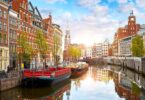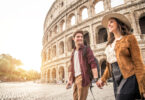Chicago is many things to many people, but one thing the city is particularly known for is its commitment to art and architecture. And this commitment extends far beyond the world-renowned Art Institute of Chicago: it’s a city so replete with artistic riches that they veritably spill onto the streets. Specifically, Chicago offers a compelling array of public artworks, embodying Chicago’s belief that culture should be a democratic and shared experience. From iconic sculptures to innovative installations, the Windy City is a veritable open-air gallery, enriching the urban landscape and the lives of both residents and visitors.
A leisurely stroll through Chicago’s bustling downtown and its many scenic parks reveals a world-class gallery of works by such renowned artists as Alexander Calder, Pablo Picasso, and Joan Miró, each contributing to the city’s dynamic cultural landscape. Whether you’re drawn to the playful abstraction of Calder’s Flamingo or the reflective allure of Kapoor’s Cloud Gate, there’s no shortage of art to engage your senses.
And, remarkably, it’s all free. Chicago’s public art is not only a feast for the eyes but also a testament to the city’s ongoing dedication to making art accessible and engaging for everyone. This open invitation to explore creativity in its many forms is just one of the reasons Chicago continues to captivate and inspire visitors from around the world.
Alexander Calder — Flamingo (1974)

Flamingo (1974), Alexander Calder, Federal Plaza, Chicago
Alexander Calder’s Flamingo, a striking sculpture located in Federal Plaza, is a celebrated piece of public art in Chicago. Unveiled in 1974, this vivid, vermilion-colored artwork stands 53 feet tall, its bold color and open steel structure contrasting sharply with the surrounding austere federal buildings. Calder’s design invites viewers to engage with the space through its arching forms and sprawling legs, which allow people to walk underneath and through the sculpture, experiencing it from multiple perspectives.
Calder famously popularized mobiles as an artistic form, but he also worked extensively in what he called “stabiles,” essentially works that imply movement but don’t actually move. Flamingo’s abstract shape suggests the elegance of a bird, while its interconnected forms and the absence of a traditional base challenge viewers to ponder its balance and composition. Flamingo is a prime example of Calder’s genius in transforming industrial materials into lively, dynamic forms, making it a focal point of both artistic and community interaction in the heart of Chicago.
Pablo Picasso — Untitled (1967)

Picasso by Phil Roeder licensed under CC BY 2.0 DEED
In the heart of Daley Plaza stands one of Chicago’s most intriguing pieces of public art: an untitled monumental sculpture by Pablo Picasso. Unveiled in 1967, this bold, 50-foot-tall sculpture was the first such major public piece by Picasso in the United States, and it marked a significant moment in Chicago’s cultural history. Crafted from Cor-Ten steel, the sculpture’s abstract form has been the subject of much speculation and interpretation. Some see in it the likeness of an animal, possibly a baboon, or a mythical creature, reflecting Picasso’s renowned abstract style, although the piece does strongly suggest the female forms in Picasso’s seminal Les Demoiselles D’Avignon (1907).
This enigmatic sculpture not only challenges viewers with its ambiguous form but also invites interaction, serving as a popular meeting spot in the plaza. Its robust, weathered material merges seamlessly with the urban fabric, standing as a testament to Chicago’s embrace of modern art in public spaces. The Picasso sculpture remains a cornerstone of the city’s artistic identity, drawing visitors and art enthusiasts from around the world.
Joan Miró – Chicago (1981)

Miro’s Chicago (1981), Joan Miro by Sharon Mollerus licensed under CC BY 2.0 DEED
Chicago, also known as Miro’s Chicago, is a striking sculpture by Catalonian artist Joan Miró that graces the Brunswick Plaza in the city. Unveiled in 1981, this colorful and imaginative piece stands at an impressive height of 39 feet, showcasing Miró’s distinctive style that blends abstract and figurative elements. The sculpture, conceived in 1969 and realized years later through a mix of fundraising and public enthusiasm, features a whimsical combination of forms and colors typical of Miró’s work.
The base of the sculpture is a simple, black, steel column that contrasts sharply with the vibrant and complex forms above, which are composed of brightly colored tiles, fiberglass, and bronze. This playful interplay of textures and hues captures the eye and sparks the imagination. Chicago is not just a visual landmark but also a symbol of the city’s rich artistic culture and its longstanding commitment to public art, enhancing the urban environment with a touch of surrealism and joy.
Marc Chagall — Four Seasons (1974)

Chicago – Chagall’s Four Seasons by Wally Gobetz licensed under CC BY-NC-ND 2.0 DEED
Marc Chagall’s Four Seasons is a mesmerizing mosaic that enhances the public space of Chase Tower Plaza in Chicago. Completed in 1974, this intricate artwork spans 70 feet in length and is a vibrant mélange of colors and images that depict scenes from nature across the four seasons, reflecting Chagall’s distinctive poetic and dream-like style.
The mosaic is made from thousands of inlaid chips in over 250 colors, a testament to Chagall’s mastery of color and form. The artwork weaves together personal, historical, and mythological elements, offering a narrative that is both universal and deeply personal, resonating with Chagall’s Jewish heritage and his experiences in life. Gifted to the city of Chicago by the artist, Four Seasons is encased in glass for protection against the elements, ensuring that this cherished work can be enjoyed year-round. It stands as a significant piece of public art and as a beloved landmark, inviting passersby to pause and immerse themselves in its rich, storytelling panorama.
Anish Kapoor — Cloud Gate (2006)

Chicago – Cloud Gate by Filippo Diotalevi licensed under CC BY 2.0 DEED
Anish Kapoor’s Cloud Gate, affectionately known as “The Bean,” is one of Chicago’s most iconic public artworks. Located in Millennium Park, this massive sculpture was unveiled in 2006 and quickly became a symbol of the city. Made from 168 stainless steel plates welded together and highly polished, Cloud Gate reflects Chicago’s skyline and the clouds above in its seamless, mirror-like surface, offering an ever-changing vista of the city and its surroundings.
Spanning 33 feet in height and 42 feet in width, Cloud Gate invites visitors to walk around and under its 12-foot high arch, where they can experience the intriguing distortions of reflection that play across its surfaces. This interaction blurs the lines between sculpture and spectator, sky and city. Kapoor’s design was inspired by liquid mercury, and the sculpture’s fluid shape and reflective properties create a dynamic interplay of light and imagery, making it not just a piece of art but a participatory experience for every viewer.
Jean Dubuffet — Monument with Standing Beast (1984)

Jean Dubuffet’s Monument with Standing Beast.by Ed and Eddie licensed under CC BY-SA 2.0 DEED
Jean Dubuffet’s Monument with Standing Beast is located in front of the James R. Thompson Center. Unveiled in 1984, this sculpture is one of Dubuffet’s largest monumental works, standing 29 feet tall and crafted from white fiberglass reinforced with polyester resin. The sculpture is characteristic of Dubuffet’s “Hourloupe” style, which he developed in the 1960s. It features interlocking cellular forms painted in a stark black and white pattern that plays with visual perception.
Monument with Standing Beast is divided into four parts: a standing animal, a tree, a portal, and an architectural form, each merging abstract and figurative elements that challenge traditional forms and encourage personal interpretation. Dubuffet’s work invites viewers to engage with its playful complexity and explore the boundary between the real and the abstract. Its placement in a busy public space allows for daily interaction, serving as a constant source of curiosity and cultural enrichment for both locals and visitors to the city.
Magdalena Abakanowicz — Agora (2006)

Agora 1, Magdalena Abakanowicz by Terence Faircloth licensed under CC BY-NC-ND 2.0 DEED
Agora is an evocative installation by Polish artist Magdalena Abakanowicz, located at the south end of Grant Park in Chicago. Unveiled in 2006, this striking assembly consists of 106 headless and armless cast iron figures, each standing about nine feet tall and weighing approximately 1,800 pounds. The figures are arranged in rows but oriented in various directions, creating a dynamic interplay of forms as visitors walk among them.
Abakanowicz’s work reflects her focus on the themes of crowd behavior and individuality within a collective. The faceless, uniform figures symbolize the loss of personal identity in society, yet their scattered placement and varied orientations suggest individual movement and thought. Agora draws its name from the ancient Greek marketplaces that were central to civic life, emphasizing the installation’s role as a space for contemplation and interaction.
Louise Nevelson — Dawn Shadows (1983)

Dawn Shadows, Louise Nevelson by Terence Faircloth licensed under CC BY-NC-ND 2.0 DEED
Dawn Shadows by Louise Nevelson is a lesser-known yet significant piece of public art in Chicago, located in the serene setting of the lobby of the James R. Thompson Center. Completed in 1983, this abstract sculpture is a prime example of Nevelson’s signature style, which often involves intricate assemblages of wood painted in monochrome, though Dawn Shadows utilizes her less typical medium of black-painted steel.
This piece stands out due to its complex, box-like structure, featuring an arrangement of geometric and rectilinear forms that create an interplay of light and shadow. Nevelson’s mastery in transforming found objects into cohesive, thought-provoking sculptures is evident, as she constructs a visual dialogue through the accumulation and arrangement of these shapes. The sculpture’s towering presence and stark color highlight its dramatic and mysterious qualities, drawing viewers into a deeper exploration of form and space.
You Might Also Enjoy: Chicago Travel Brief: What to Know Before You Go
Jaume Plensa — Crown Fountain (2004)

The Crown Fountain (2004) Jaume Plensa by themusediffuse licensed under CC BY-NC-SA 2.0 DEED
The Crown Fountain, designed by Spanish artist Jaume Plensa and unveiled in 2004, is a mixture of public art and technology in Chicago’s Millennium Park. This interactive work consists of two 50-foot glass block towers at each end of a shallow reflecting pool. The towers project video images of faces of Chicago citizens, which change every few minutes, and feature a distinctive element where water spouts from a nozzle where the mouth on the video image would be, mimicking the act of spouting water, much like the classic fountains of old but with a decidedly modern twist.
This fusion of sculpture and digital art creates a dynamic interaction between the artwork and the public, inviting visitors to engage directly by wading in the pool and experiencing the water cascading off the tower’s faces. The Crown Fountain’s innovative use of LED technology and video in sculpture represents a significant leap in how public art can draw community participation and reflection.
FAQs:
Q: What are the best times of year to visit these public art pieces in Chicago?
A: Spring and fall are ideal, as the weather is mild and conducive to walking tours. However, Chicago’s public art is accessible year-round, and each season offers a distinctive backdrop for the artworks.
Q: Are there guided tours available for Chicago’s public art?
A: Yes, several organizations offer guided walking tours of Chicago’s public art, which can provide deeper insights into the artworks and artists. The city of Chicago also offers a guide for self-guided tours.
Q: How accessible are these art installations for people with disabilities?
A: Most public art installations in Chicago are wheelchair accessible. However, it’s a good idea to check specific locations for detailed accessibility information.
Q: Can I photograph the public art?
A: Photography of public art is generally allowed for personal use. Commercial use may require permission from the artist or the city, depending on the work.
Q: What if I want to learn more about the artists or the stories behind the artworks?
A: Many of Chicago’s public art pieces have plaques with information about the artists and the artwork. For a deeper dive, local libraries and the city of Chicago have resources available.
Q: Is public transportation available to these art sites?
A: Yes, Chicago’s public transportation system provides access to most of the public art locations. The use of buses and the “L” train is recommended for easy and affordable travel throughout the city.
Do you have a favorite piece of public at in Chicago? Tell us about it in the comments below!








